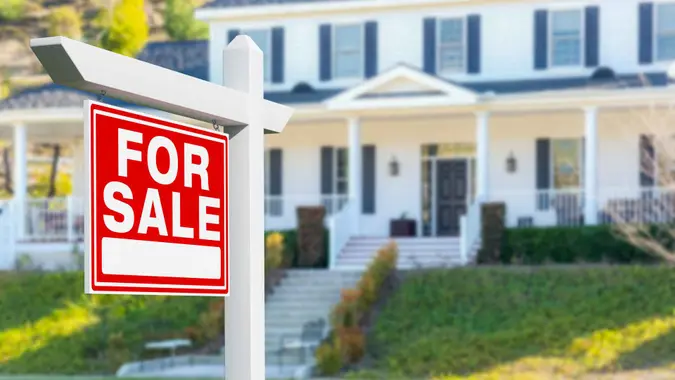The Middle-Class Guide to Homeownership in 2024

Commitment to Our Readers
GOBankingRates' editorial team is committed to bringing you unbiased reviews and information. We use data-driven methodologies to evaluate financial products and services - our reviews and ratings are not influenced by advertisers. You can read more about our editorial guidelines and our products and services review methodology.

20 Years
Helping You Live Richer

Reviewed
by Experts

Trusted by
Millions of Readers
If you’re a middle-class individual or couple looking to become a homeowner in 2024, know that while there may be some challenges ahead, you shouldn’t let that stop you from accomplishing your goal.
“In some areas, inventory is still low because people don’t want to let go of the low interest rate they secured for their mortgage to then purchase at a higher rate,” said Marcy Downey, loan originator at Motto Mortgage Signature Plus. “It is not really a seller’s or a buyer’s market, but there are some things that buyers can do in this market to be prepared.”
Here’s your guide to help make things go more smoothly.
Know How Much House You Can Afford
“You need to decide how much of a monthly housing expense you can afford and then make sure you can qualify for that amount,” Downey said. “The monthly housing expense includes the principal and interest payment, private mortgage insurance if you put less than 20% down, 1/12th of the annual property taxes, 1/12th of the annual homeowner’s insurance premium and the monthly HOA fee if applicable.”
Don’t Focus on the Current Housing Market Rate
“Focus on what the monthly payment for the mortgage amount and that rate is,” Downey said. “The phrase ‘marry the house and date the rate’ is one that resonates with people. If you love the home, make the commitment and know that you may have an opportunity to refinance the mortgage in the future.”
As long as you get a fixed-rate mortgage, she said, your monthly payment will increase only if the taxes or insurance change.
Understand How Private Mortgage Insurance Works
Private mortgage insurance, typically required if you put less than 20% down, protects your lender in the event that you stop making payments on your loan.
“The private mortgage insurance (PMI) will go away once you have 20% equity in your home with a conventional mortgage,” Downey said, “but, with an FHA mortgage, the PMI stays with the mortgage for the life of the loan unless you put more than 10% down at the time of closing — in which case it will go away in Year 11. This is another way to lower your payments in the future.”
Enjoy a Less Competitive Market Earlier in the Year
Even though interest rates may be higher than you would like, you are going to start building equity, Downey pointed out. Additionally, she said, higher rates mean there are fewer buyers to compete with.
“The National Association of Realtors notes that typically for each 1% in rate drop, there are 5 million more eligible buyers in the market,” she said, “making the market more competitive and perhaps raising prices.”
Remember: You Have Options
Downey said there are lots of loan options to meet the needs of different buyers.
“If you are a first-time homebuyer, there are conventional loan products allowing you to put down as [little] as 3%,” she said. “FHA buyers can put down as [little] as 3.5%. FHA loans also allow a little more flexibility for a higher monthly debt to income ratio. If you are eligible for a VA loan, that may also be your best option, with no money needed for the down payment.”
Don’t Forget About Closing Costs
“Closing costs can come from gift funds or seller concessions, but typically come from your own funds,” Downey said. “Closing costs include things like title fees, homeowner’s insurance (you’ll have to pay for the first year up front), underwriting and processing fees, survey cost, appraisal fees and initial escrows.”
Downey suggested understanding your “total cash to close” so you can budget for the expense.
“There are down payment assistance programs out there,” she said, “but you have to qualify based on credit score and in some cases income and/or debt to income.”
Make Sure You Have Enough Money in Your Budget To Own a Home
Downey said to subtract your monthly debt obligations — new housing expense, car payments, credit cards, personal loans — from your monthly take-home pay to make sure you’ll have enough left to pay utilities and other bills while still having enough to put aside in case you need to spend money on home improvements and repairs.
“You don’t want to overextend yourself,” she said. “This goes back to creating a budget, whether it be to figure out how much you need to save to get into a home or how much you want to put aside each month to have a rainy-day fund. Make the goal manageable and attainable.
“If you want to save and put aside $6,000 a year, break it down into monthly ($500) and then weekly ($115.38) and even daily ($16.44) amounts. Think about something that you might be able to eliminate in your daily spending that would allow you to reach your goal. Perhaps even think about opening a savings account or some type of interest-bearing account that you cannot touch that is specifically set aside for housing expenses.”
The Takeaway
Becoming a new homeowner is an exciting milestone.
“Set a goal and go make it happen,” Downey said. “Stay focused on what you can control, and the rest will fall into place.”
 Written by
Written by  Edited by
Edited by 

























